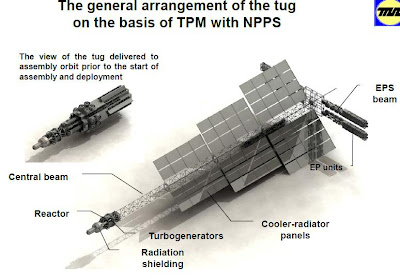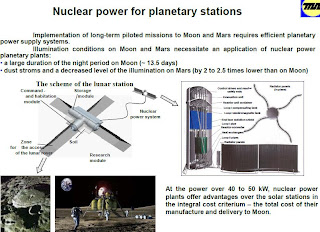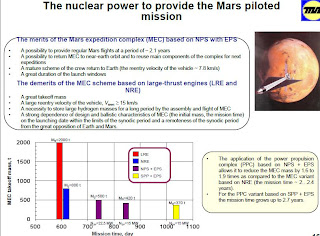Russia is claiming progress on a megawatt nuclear space propulsion engine. They had previously stated the system would be ready by 2017.
Ruscosmos is about a reusable gas-cooled fission reactor that powers a generator. This would power a plasma thruster.
They have made some physical models and some video simulations. They claim to have made components and a drip heat radiator.


Russian nuclear rocket claims from 2016, 2011 and 2010
“At present we are testing several types of fuel and later we will start drafting the design,” Kovalevich said. “The first parts [of the nuclear engine] should be built in 2013, and the engine is expected to be ready by 2017.”
The engine is being developed for interplanetary manned spacecraft to ensure that Russia maintains a competitive edge in the space race, including the exploration of the Moon and Mars.
The Russian government allocated 500 million rubles ($16.7 million) in 2010 to start a project to build a spacecraft with a nuclear engine. The overall investment in the project is estimated at 17 billion rubles (over $580 million) until 2019.
According to Russia’s nuclear power agency Rosatom, the development and construction of a nuclear propulsion system for spacecraft will cost over 7.2 billion rubles ($247 mln).
Nextbigfuture covered Russia’s plans for a megawatt nuclear space propulsion system back in 2011.
It would have an ISP of 3000-6000. A 6000 ISP megawatt system might be able to send a compact unmanned probe to Mars in 6 weeks.
A presentation discussed nuclear power sources for space up to 1 megawatt for flying to Mars, moon base power and for orbital tugs.
A qualitatively new stage in the development and practical application of atomic energy in space is linked with the use of multipurpose high-capacity propulsion-power modules. Their design based on a nuclear powered propulsion facility in the megawatt range has been approved and accepted for implementation. In this article, the facility is described, the principles of operation of the facility as a whole and its individual subsystems are examined, and the proposed characteristics and mass of the structural elements are presented. The advantages of using atomic energy in the power-plant–motor variant, including for manned flight to Mars, are shown.
Russia is looking closely at plasma thrusters as well
* hybrid two-contour scheme, a plasma generator driven by reactor-produced electricity yields specific impulse 20 times higher than chemical propulsion
* inner contour of the reactor with circulating working agent at 1500 C
* development started in 2010
* plans to complete initial design by 2012
* prototype working by 2015
* cargo module ready for flight in 2018
The new plan would be 4 years late on the design work and then 2 years late on the working prototype.
Bigger Russian nuclear space designs
In 2008, Open-cycle multi-megawatt MHD space nuclear power facility
The results of calculations of the characteristics and development of a scheme and technical make-up of an open-cycle space power facility based on a high-temperature nuclear reactor for a nuclear rocket motor and a 20 MW Faraday MHD generator are presented. A heterogeneous channel-vessel IVG-1 reactor, which heated hydrogen to 3100 K, with the pressure at the exit from the reactor core up to 5 MPa, burn rate 5 kg/sec, and thermal power up to 220 MW is examined. The main parameters of the MHD generator are determined: Cs seed fraction 20%, stopping pressure at the entrance 2 MPa, electric conductivity ≈ 30 S/m, Mach number ≈ 0.7, magnetic induction 6 T, electric power 20 MW, specific energy extraction ∼4 MJ/kg. The construction of the scheme of a MHD facility with zero-moment exhaust of the working body and its main characteristics are presented.

Brian Wang is a Futurist Thought Leader and a popular Science blogger with 1 million readers per month. His blog Nextbigfuture.com is ranked #1 Science News Blog. It covers many disruptive technology and trends including Space, Robotics, Artificial Intelligence, Medicine, Anti-aging Biotechnology, and Nanotechnology.
Known for identifying cutting edge technologies, he is currently a Co-Founder of a startup and fundraiser for high potential early-stage companies. He is the Head of Research for Allocations for deep technology investments and an Angel Investor at Space Angels.
A frequent speaker at corporations, he has been a TEDx speaker, a Singularity University speaker and guest at numerous interviews for radio and podcasts. He is open to public speaking and advising engagements.








….
3. Wannabe terrorist organisations like “Greenpeace” and “Friends of the Earth” don’t enjoy idiot privileges.
Mainly it is the US (manipulated by Jews) who is trying to conquer the whole World, tell other nations what is good or not, how to live, who to make business with. The US is the main World terrorist unfortunately. Great power, used for bad purpose.
Solar is so stone age.
Why not,they have already the experience how to blow up a nuclear reactor like Chernobyl
and with fukashima pouring out tons of radiation into the ocean and with a nuclear rocket
now and maybe blowing up in the sky whats another catastrophe maybe die sonner.
I call all these mad scientist making doomsday weapons.
I wish them the best and hope it works, the world could really use Russia and her engineers added to the goal of space exploration and commercialization. They have some top notch engineers and physicists with a very high experience level designing and working on space projects.
I blame the really poor leadership of the governments of Russia, China and the US for creating problems for no reason. If they were not busy playing dominance games and instead focused on providing a stable environment for businesses to expand into space we would progress much faster.
I’m with you. The Russians do have a good chance of being first with a nuclear propulsion rocket, if only because they have the combination of
1. Large amounts of proven nuclear tech
2. A government that would let them do it.
yeah. they’ll say it was “their” fault
tehyetry
I would also like to announce I’ve made SIGNIFICANT progress to a working FTL drive…
…it’s easy to claim/make powerpoint slides.
Good font selection on that PPT.
Yes that’s all I have to say.
The difference between him and you is he’s correct. He can also put together a sentence and use grammar correctly, unlike yourself.
Im sure it would work. if russia gives tax breaks to their oligarchs they will find money to fund the vasimir.
Igor Ukranian troll in action..
Sheesh
I’m no apologist for Russians, however …
Four physics Nobel prizes in the last 15 years isn’t bad.
A space-qualified, megawatt class nuclear reactor has been the obvious answer to many space power & propulsion issues for over 70 years.
Russia doesn’t do “politically correct”, they do (sometimes) brute force/less sophisticated Engineering.
Even as they mess up, they persevere.
And you might consider that big, yellow thing that rises every morning, dumping gigatons of fusion fragments unto the Earth over the last 4 billion years or so.
Make a burst reactor.
Spin a cylindrical, annular vessel, containing UF6 – the fluoride settles/condenses on inner diameter of the vessel and becomes solid – the process is aided by centripetal force. Obviously, it must be held sub-critical in this state… pick one or two ways to do that. Connect this vessel to an expansion chamber with a relief valve or a rupture disk.
Put a second cylindrical vessel of much smaller diameter in the center of the annular vessel; this inner vessel contains water and its rupture disk is at the throat of a vacuum rocket nozzle with ablative coating. The inner vessel walls should be made of unobtanium, which is something of low mass number and incredible mechanical strength in tension, which lets xrays through to heat the water while containing water at 30k-bar at 10,000C. 3D printed mono-crystalline diamond could substitute for unobtainium in a pinch.
Now, eject the shutdown mechanism super quickly and everything except the cases turns to plasma instantaneously. The annular vessel vents the UF6 to its expansion chamber; the central vessel vents the dissociated, ionized water to the rocket nozzle.
Repeat as soon as it cools down.
While I don’t see it explicitly stated here, this can’t be for anything but second stages as the thrust would be nowhere near enough to reach orbit (and if I’m wrong, I’d love to see some numbers). That’s not saying this isn’t a great idea, but I’d imagine that second stage would be very massive, which means with current Russian launch systems, a not-very-useful payload…?
This reminds me of a statement from the head guy from Ruscosmos saying, basically, that they “weren’t worried about SpaceX and their old tech”. Besides continuous presence as an orbital tug or an interplanetary probe, I can’t think of a situation where this nuclear design would outclass the BFS. Makes for good chest pounding, though!
Oh yeah… brought to us by the authors of the worst nuclear accident in world history… I wonder what their spin will be when we’re taping our doors and windows shut as strontium-90 rains down all around us…
It disposes the nuclear fuel over South East Asia as it rises up but can be refueled when needed!
Soviet style SpaceX!
It is better be reusable, not disposable rocket.
It is better be reusable, not disposable rocket.
Good font selection on that PPT.
Yes that’s all I have to say.
The difference between him and you is he’s correct. He can also put together a sentence and use grammar correctly, unlike yourself.
I wish them the best and hope it works, the world could really use Russia and her engineers added to the goal of space exploration and commercialization. They have some top notch engineers and physicists with a very high experience level designing and working on space projects.
I blame the really poor leadership of the governments of Russia, China and the US for creating problems for no reason. If they were not busy playing dominance games and instead focused on providing a stable environment for businesses to expand into space we would progress much faster.
I’m with you. The Russians do have a good chance of being first with a nuclear propulsion rocket, if only because they have the combination of
1. Large amounts of proven nuclear tech
2. A government that would let them do it.
yeah. they’ll say it was “their” fault
Im sure it would work. if russia gives tax breaks to their oligarchs they will find money to fund the vasimir.
Igor Ukranian troll in action..
Sheesh
tehyetry
I’m no apologist for Russians, however …
Four physics Nobel prizes in the last 15 years isn’t bad.
A space-qualified, megawatt class nuclear reactor has been the obvious answer to many space power & propulsion issues for over 70 years.
Russia doesn’t do “politically correct”, they do (sometimes) brute force/less sophisticated Engineering.
Even as they mess up, they persevere.
And you might consider that big, yellow thing that rises every morning, dumping gigatons of fusion fragments unto the Earth over the last 4 billion years or so.
It disposes the nuclear fuel over South East Asia as it rises up but can be refueled when needed!Soviet style SpaceX!
It is better be reusable, not disposable rocket.
Make a burst reactor.
Spin a cylindrical, annular vessel, containing UF6 – the fluoride settles/condenses on inner diameter of the vessel and becomes solid – the process is aided by centripetal force. Obviously, it must be held sub-critical in this state… pick one or two ways to do that. Connect this vessel to an expansion chamber with a relief valve or a rupture disk.
Put a second cylindrical vessel of much smaller diameter in the center of the annular vessel; this inner vessel contains water and its rupture disk is at the throat of a vacuum rocket nozzle with ablative coating. The inner vessel walls should be made of unobtanium, which is something of low mass number and incredible mechanical strength in tension, which lets xrays through to heat the water while containing water at 30k-bar at 10,000C. 3D printed mono-crystalline diamond could substitute for unobtainium in a pinch.
Now, eject the shutdown mechanism super quickly and everything except the cases turns to plasma instantaneously. The annular vessel vents the UF6 to its expansion chamber; the central vessel vents the dissociated, ionized water to the rocket nozzle.
Repeat as soon as it cools down.
While I don’t see it explicitly stated here, this can’t be for anything but second stages as the thrust would be nowhere near enough to reach orbit (and if I’m wrong, I’d love to see some numbers). That’s not saying this isn’t a great idea, but I’d imagine that second stage would be very massive, which means with current Russian launch systems, a not-very-useful payload…?
This reminds me of a statement from the head guy from Ruscosmos saying, basically, that they “weren’t worried about SpaceX and their old tech”. Besides continuous presence as an orbital tug or an interplanetary probe, I can’t think of a situation where this nuclear design would outclass the BFS. Makes for good chest pounding, though!
I would also like to announce I’ve made SIGNIFICANT progress to a working FTL drive…
…it’s easy to claim/make powerpoint slides.
Oh yeah… brought to us by the authors of the worst nuclear accident in world history… I wonder what their spin will be when we’re taping our doors and windows shut as strontium-90 rains down all around us…
It disposes the nuclear fuel over South East Asia as it rises up but can be refueled when needed!
Soviet style SpaceX!
It is better be reusable, not disposable rocket.